Can You Put Clear Acrylic Gel Over an Art Print?
This how-to guide to working with acrylic paint mediums, gels, pastes and more will help yous expand the possibilities in every painting.
By Sandra Duran Wilson
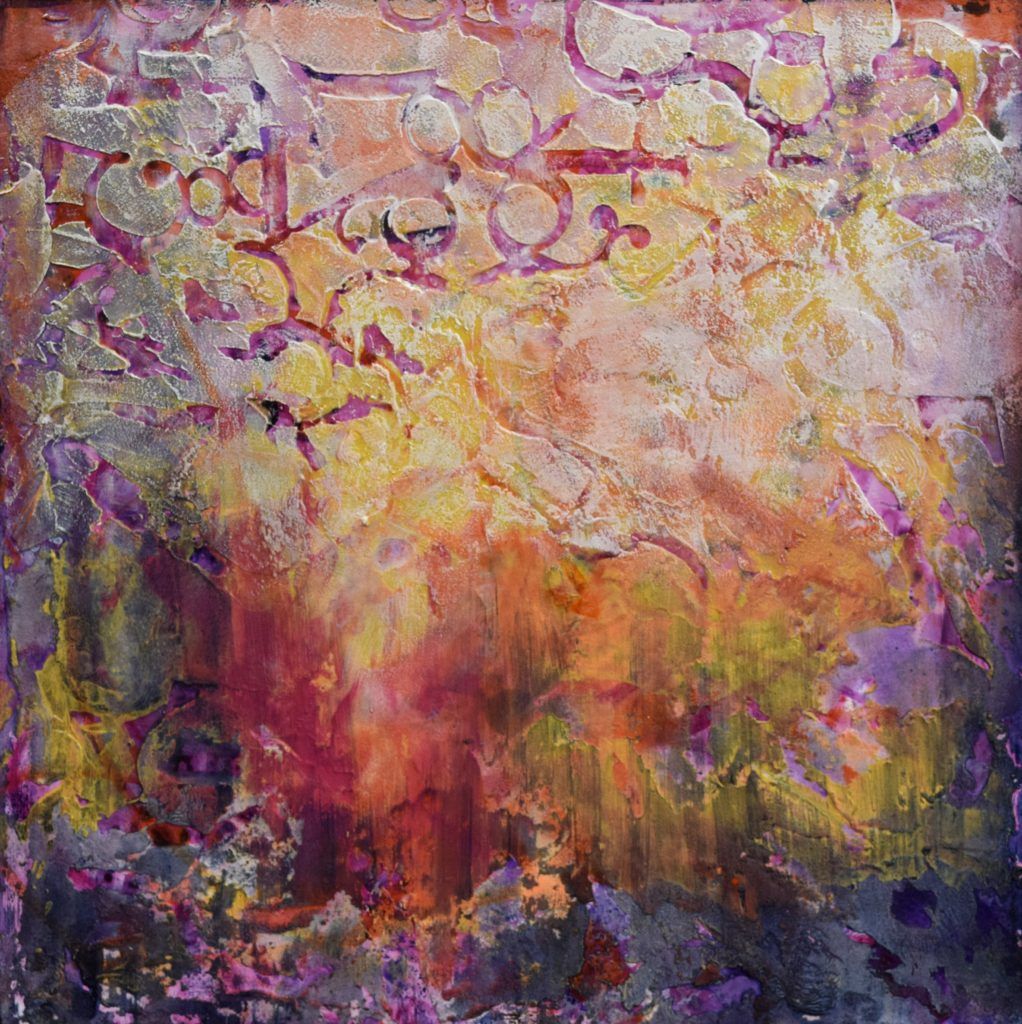
When you walk into the fine art supply store, are you befuddled past the rows of acrylic products and acrylic paint mediums that all look the same? You're not lone. In this commodity, I'thousand unraveling the mysteries of acrylic paint mediums, gels, and pastes. Each production has qualities that enable acrylic painters to accomplish a multitude of special effects and textures. For the best results, I recommend starting with artist's grade acrylic paint, even if you're just getting started with acrylics.
1. Gels
Gels are bachelor in a variety of viscosities (the product's thickness), such equally soft, regular, heavy, and extra-heavy torso. There are as well sheen options including matte, semi-gloss and gloss. When choosing a viscosity, remember that the college the viscosity, the college the peaks. Gels can cause acrylic pigment to compress; examination for this, and consider a high-solid gel product to avert shrinkage.
White When Wet, Articulate When Dry
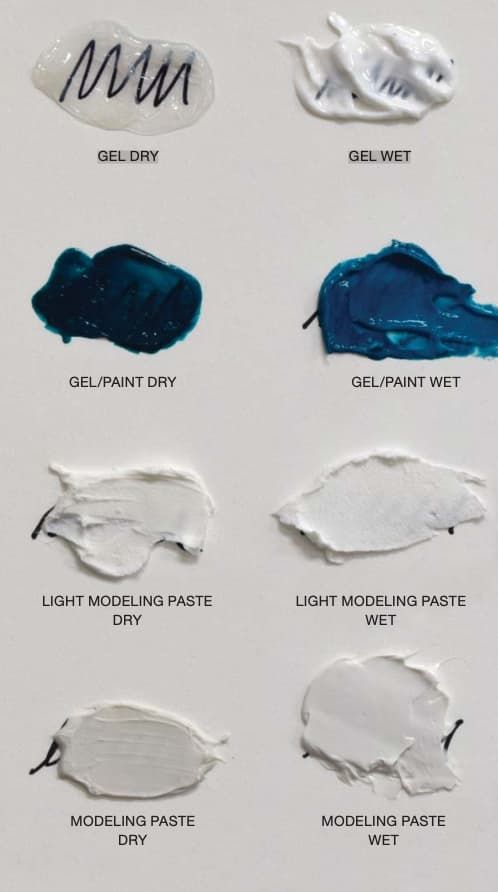
In general, gels are white when wet, and transparent when dry. They're like colorless paint. One do good of incorporating gels is their ability to extend your paint, thus saving you lot money. It may accept some hands-on do to become accustomed to how gels collaborate with colour. When gel is added to paint, the color of the pigment becomes lighter, just dries to its out-of-the-tube color. I recommend making a chart illustrating the differences until yous become familiar with gel's consequence on paint, such as my chart above.
Creating Texture and Sgraffito Effects With Gels
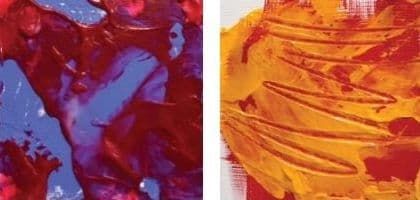
Create texture. You can create soft folds or high rigid peaks with your acrylic paint depending on the viscosity of the gel. To create a transparent layer without much texture, use a palette knife to spread a layer of soft gel gloss. Permit the layer dry out before adding additional layers. This method creates wonderful visual depth. Or, mix color into the gel and spread it over a groundwork color to create layers of color.
In the example to a higher place, I painted the background violet and permit dry. I mixed a small-scale amount of quinacridone red into soft gel semi-gloss and used a pocketknife to spread the mixture. I then practical some of the mixture in sparse layers and some in thick layers and left other areas unpainted to permit the violet background to show through. To create high peaks, mix heavy gel with your paint. This technique also extends the paint's book.
Sgraffito is a fun way to add broken color to your surface. In the above image, I painted the background with pyrrole red. When dry, I scraped a layer of heavy gel gloss mixed with diarylide yellowish over the surface using a palette pocketknife. While the gel mixture was still wet, I drew on the surface with a knife tip, revealing the underlying colour. Notice that I didn't thoroughly mix the paint into the gel. As a result, I achieved an almost marbled outcome with the yellowish rather than a solid mass.
Altering Sheen With Gels

Acrylic paints tend to be glossy when dry, merely you can have control of the sheen by adding acrylic paint mediums like semi-gloss or matte gel to the pigment.
Gloss: The background color is Liquitex brilliant aqua greenish. When dry, a layer of phthalo turquoise was mixed with soft gel gloss and spread with a knife over the surface. On the left side, I applied a thick awarding; the right has a thin awarding. The black lines were painted on the background to indicate transparency.
Matte: I mixed Naphthol red light into semi-gloss regular gel and spread the mixture in a thin application on the left and a thicker application on the right. I too was able to control the paint's transparency.
In the terminal example, I altered the paint'southward sheen by applying a layer of gel over the dry out paint. I practical matte gel on the left side and semi-gloss on the correct.
Extending Paint Book With Gels
Extend your paint by mixing it with gels. I oftentimes add a few drops to a tablespoon of gel into my paint, working information technology together with a knife. I adopt using a knife over a brush because the gel can clog a paintbrush and create unsightly brush marks.
ii. Polymer Mediums
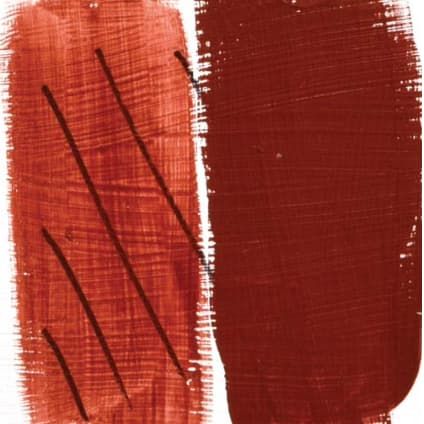
This product is a pourable acrylic paint medium. As with gels, information technology's white when wet and clear when dry, and is a great paint extender. I like to employ a knife to mix my paint into the medium. You may also apply a brush since polymer medium has a lower viscosity than the previously discussed gels. Polymer medium makes opaque paint more transparent.
Blood-red iron oxide, a mineral color, is opaque, and it becomes more transparent when a polymer medium is added. Y'all tin can see how the night lines bear witness the transparency.
Blending and Glazing with Polymer Mediums
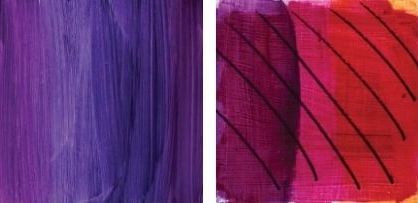
Blending. Polymer medium makes it easier to blend colors together and, when a bit of water is added to the mix, the open time is extended. In the prototype in a higher place, used a combination of Payne's gray and permanent violet night, both mixed with polymer medium, and composite the ii colors together.
Glazing. The difference between a mixture of paint with polymer and glazing medium with pigment is that the glazing medium has a retarder added so it doesn't dry as chop-chop. Y'all may add together some water to the polymer mixture to increase its open fourth dimension.
In the instance to a higher place, I painted the background with quinacridone magenta. When dry, I painted a glaze made of polymer medium and permanent violet dark on the left side. Next, I painted the right side with a similar mixture using transparent pyrrole orangish. The strip down the center of the prototype reveals the quinacridone magenta background color.
Color Mixing by Layers with Polymer Mediums
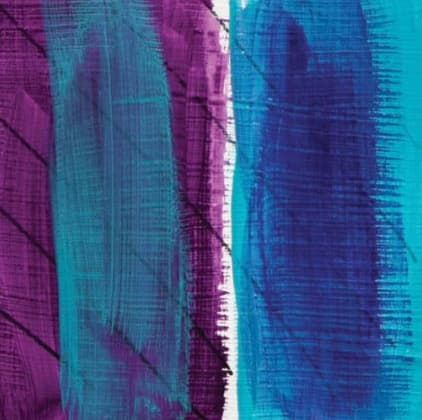
Create vibrant colors by layering paints rather than blending colors. For example, pigment a color, let it dry, and then layer a new color that has been mixed with a polymer medium. In the prototype to a higher place, I painted the left side with permanent violet dark. When dry, I painted a mixture of cobalt teal and polymer medium over the surface. On the right side, the colors are reversed. I find that making a chart of some of my favorite layer combinations comes in handy while painting with acrylic paint mediums.
Working With Fluid Matte Medium
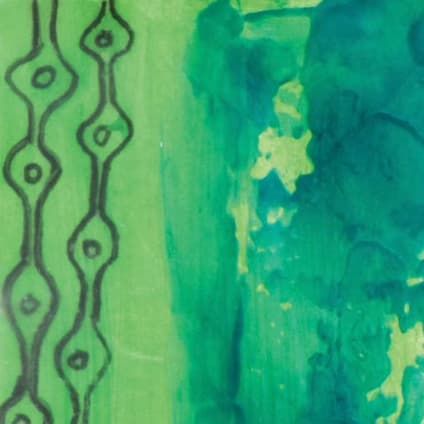
This is a pourable medium with particulates added to give it a matte appearance. This product lightly veils, or pushes color intensity back, creating a wax-similar appearance. When I'm building a surface with many color layers, l use polymer medium gloss with the color layers and finish with fluid matte medium at the end.
In my sit-in image, I painted the groundwork a calorie-free greenish and immune information technology to dry. Next, I applied a layer of fluid matte medium and permit that dry. To add a blueprint element, I drew on the left side of the canvas with a soft pencil, and practical boosted fluid matte medium over the drawing. On the right side, I mixed permanent green into the medium.
3. Pastes
Here, we'll examine modeling paste, coarse paste and light modeling paste. You might as well see difficult and flexible pastes. Pastes are white when wet and opaque when dry out . Pastes contain marble grit to give them opacity. Manufacturers name their pastes differently, calling them molding or modeling, but they're the aforementioned.
Modeling Paste and Embossed Textures
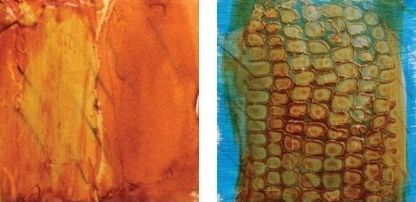
Modeling Paste. The paste has a thick viscosity, and then spread it with a palette knife. I prefer to spread the paste, allow dry and and so add pigment on height. Molding paste is a chip more absorbent than the gels, but non every bit absorptive as the light molding paste. Depending on the thickness in which it's applied, it may be translucent or opaque. In the example to a higher place, I practical modeling paste on the left side and lite molding paste on the right. Then I brushed watered-downwards quinacridone gilt over both sides. As yous can meet, the correct side is far more absorbent.
Embossed Texture. In the example higher up, I painted bluish azure equally a background. When dry, I applied a thin layer of modeling paste. While wet, I pressed a textured paper into the paste and removed. When the paste was dry, I brushed on watered-down quinacridone gold paint.
Light Modeling Paste and Textural Peaks
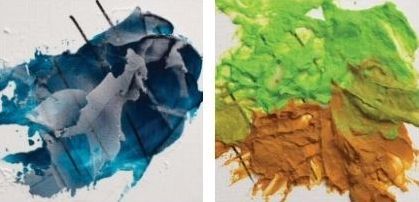
Light modeling paste. Light modeling paste has the viscosity of whipped cream and is very absorbent. When it's practical in a sparse layer, it can human action like a veil. If information technology's thicker, it becomes opaque. I painted phthalo turquoise every bit a groundwork color in the sample prototype to a higher place. When the color was dry, I spread a thin layer of light molding paste on pinnacle of it with a palette pocketknife. Observe that in areas where information technology's thicker, it shows equally white.
Textural Peaks. Light modeling paste tin hold extremely high peaks and is a lightweight culling to heavy modeling paste. You lot can apply information technology in thick impasto layers onto large stretched canvas without fright of the canvass pulling off the stretcher confined due to its weight. In my example above, I mixed bright lime dark-green and yellow ochre with the calorie-free modeling paste, and drew the paste up with my palette knife to create peaks.
Opacity and Lightening Colors With Light Modeling Paste
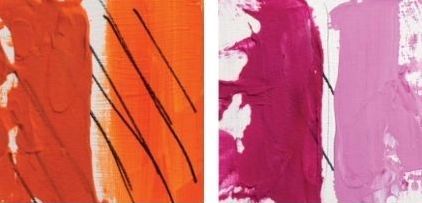
Opacity. Where gels and mediums make opaque paints more transparent, light molding paste makes paint less transparent. This works especially well with mod colors. In the example higher up, I mixed transparent pyrrole orange with low-cal modeling paste on the left-manus side. The right features just pigment.
Lightening colors. Light modeling paste has a unique quality that'due south very handy. Mixing mod colors with white tends to yield pastels, merely low-cal modeling paste lightens colors without making them dull. In the sample epitome above, I mixed quinacridone magenta mixed with light modeling paste on the left; on the right, I mixed the same paint with titanium white. I used equal amounts of paste and paint.
Combo Practice: Light Modeling Paste and Iridescent Bronze Paint
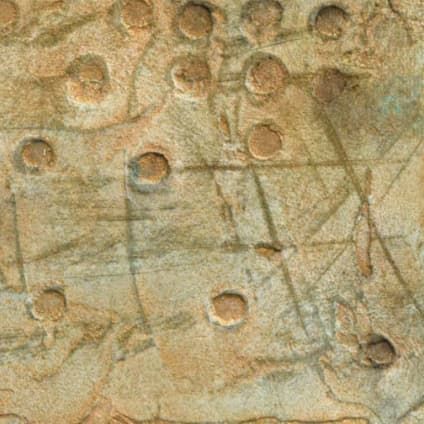
Try this combination. Light modeling paste is very absorbent, holds textures well, and when combined with the unique properties of Gold iridescent statuary, makes for a beautiful finish. Hither's a fun exercise: I practical light modeling paste and while wet, pressed a dowel into the paste to create interesting marks. When the paste was dry, I brushed on a very watered-downwards irised statuary paint. This simply works if the pigment is very diluted. It takes a few minutes for the bronze particles and the green color to separate.
Fibroid Molding Paste
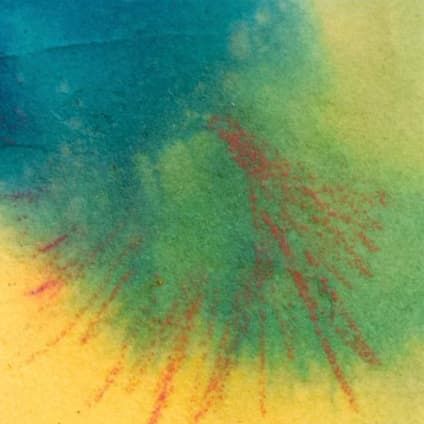
This paste has a bit of grit to it and it dries to an off-white grey stop. The molar makes it platonic for drawing or using pastels on top of it. Try using information technology to prepare a surface for pastels or as a unique painting surface. For the example above, I spread the paste in a sparse layer. When dry out, I practical fluid paints on the surface, creating nigh a watercolor paper expect. When the pigment was dry, there was still enough tooth to draw on it with a cherry-red pastel pencil.
4. Combining Acrylic Paint Mediums, Gels, and Pastes
Ii or More Pastes
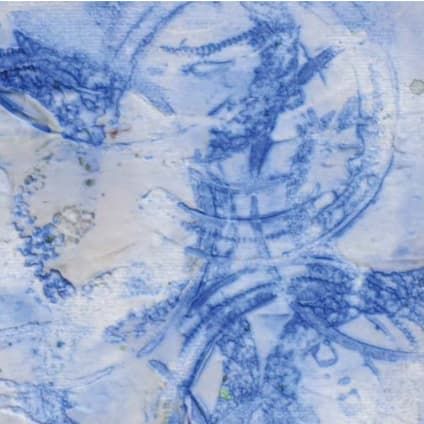
Combining Pastes. Mixing two or more of the pastes together can create fifty-fifty more viscosities, absorbencies, transparencies and textures. I placed a small-scale amount of the three different pastes onto the surface and used a palette pocketknife to blend them together in the prototype higher up. I didn't completely mix them, but let their backdrop overlap. While the pastes were still wet, I pressed plastic lids or other objects into them to create texture. I permit the pastes dry and so brushed on a watered-down paint of cobalt blue.
Combining Gels and Pastes
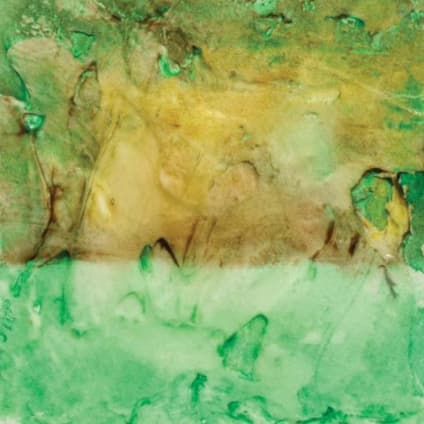
Gels and Pastes. When you combine the transparency of gels and the opacity of the pastes, you lot get an interesting surface texture. I frequently spring-start a painting by creating a surface using both pastes and gels. I created the background above by roughly mixing modeling paste, calorie-free modeling paste, and regular gel gloss. Then I spread the mixture using a knife to create deep texture. When dry, I brushed on a watered-down green paint. When dry, I brushed a brown glaze over the superlative half. Adding the darker color enhanced the texture.
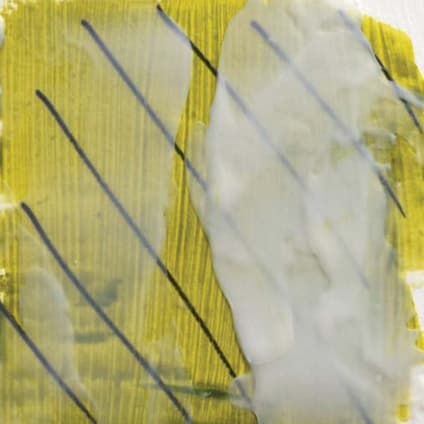
Hybrid. Extra-heavy gel molding paste by Golden is a hybrid mix of paste and gel. In this case, I applied a background color of green/gold. When dry, I added the hybrid mix. This hybrid mix is opaque in a thick application and translucent in a thin layer.
Pumice Gel and Combination Pumice Layers
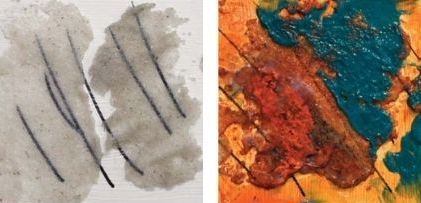
Pumice Gel. This is really a specialty gel. I like to mix it with a gel so it's easier to spread. I can also change the transparency and the absorbency depending on the gel I mix with the pumice. Y'all may find it equally fibroid pumice or ceramic stucco depending on the brand. In the epitome above, the left side has pumice applied, and the right side has pumice mixed with soft gel gloss. I could alter the absorbency and transparency by mixing information technology with matte gel, or I could even make my own coarse molding paste by mixing the pumice into the paste.
Combination Pumice Layers. Here I, put a combination of pumice and gel onto the surface and let the products dry out. Then I flowed a watered-down quinacridone golden paint over the surface so it settled into the recesses. When dry out, I added a gel layer. The right side has cobalt turquoise mixed into the regular semi-gloss gel, and the left side has untinted gel spread over the surface. When this layer was dry, I rubbed an orange color over the surface.
Acrylic Paint Mediums and Gels equally Collage Adhesives
The acrylic gels and mediums we've been reviewing work beautifully as archival collage adhesives. Match the weight of your paper to the weight of the gel. For example, if yous're going to gum a sparse newspaper, use polymer medium. A regular-weight paper would have soft gel, and a heavyweight newspaper would need a heavyweight gel. I prefer to employ gloss gels when gluing considering they dry out the clearest. I tin always alter the last sheen by adding a layer of gloss, semi-gloss or matte.
The techniques and textures that gels, pastes and acrylic paint mediums make possible are priceless. I find I buy paint a lot less frequently, and I beloved creating textures with the assorted products. I know how to alter the transparency, change viscosity and create rich colors past layering colors with mediums and gels. The key is assuasive the layers to dry in between and compensating for the shift from white to clear. Experiment and chart your results!
Meet the Artist
SANDRA DURAN WILSON is an abstruse American painter and sculptor based in Santa Atomic number 26. She's been painting professionally for more than 20 years, and her work is represented in public and private collections. She shares her noesis through workshops, writing and DVDs. Learn more at sandraduranwilson.com.
A version of this article beginning appeared in Acrylic Artist mag.
Source: https://www.artistsnetwork.com/art-mediums/acrylic/your-guide-to-acrylic-paint-mediums-gels-and-pastes/
0 Response to "Can You Put Clear Acrylic Gel Over an Art Print?"
Post a Comment